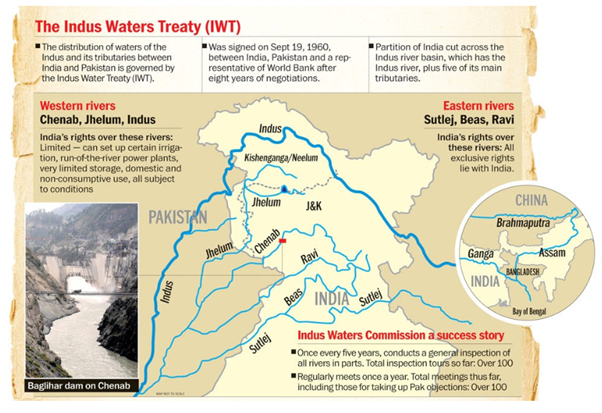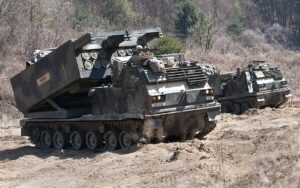Table of Contents
Marital Rape
Context: Recently Chief Justice of India stated that, if the Union government did not file a response to petitions before the Supreme Court seeking the criminalisation of marital rape. It would have to present oral arguments on the tenets of the law when the case comes up for hearing.
About Marital Rape
- Section – 375 of IPC:
- It defines rape as sexual intercourse with a woman against her will, without her consent, or under certain other circumstances.
- Exception 2 under Section -375 (IPC):
- It states that sexual intercourse between a husband and wife is not considered rape if the wife is over the age of 15.
- Changes under Bhartiya Nyaya Sanhita (BNS):
- It has retained the same exception under Section-63, but raised the age of the woman from 15 to 18.
| Related High Court Judgements |
Karnataka High Court:
|
Indus Water Treaty
Context: Recently India has issued a new formal notice to Pakistan seeking a “review and modification” of the Indus Waters Treaty (IWT).
About Indus Water Treaty (IWT)

Three-stage dispute resolution mechanism under Indus Water Treaty (1960)
- Permanent Indus Commission (PIC): The first level of dispute resolution, where either party informs the other of their plans for the Indus River.
- Neutral Expert: The World Bank appoints a neutral expert to resolve any differences.
- Court of Arbitration: If either party is not satisfied with the neutral expert’s decision, or if there is a dispute over the treaty’s interpretation, the matter goes to a Court of Arbitration.
- The World Bank appoints the chair of the Court of Arbitration.
Reasons for India’s Renegotiation Demand
- India cites “fundamental and unforeseen changes in circumstances” for its renegotiation request, including:
- Changes in population demographics
- Environmental concerns and clean energy development
- Cross-border terrorism threats
- The construction of two hydropower projects by India in Jammu and Kashmir has also sparked controversy, with Pakistan claiming that these violate the IWT.
- Kishanganga Hydroelectric Project: River- Kishanganga (Tributary of Jhelum)
- Rattle Hydroelectric Project: River- Chenab
2 Years of Project Cheetah
Context: Union Environment Minister Bhupender Yadav said the two years of Project Cheetah have been challenging, with several hurdles, from habitat adjustments to ensuring the cubs’ survival in the wild, successfully overcome.
Project Overview
- Initiation: Project Cheetah officially began on September 17, 2022, with the introduction of cheetahs sourced from Namibia and South Africa.
- Current Population: As of September 2024, there are at least 24 cheetahs in Kuno National Park, including 12 cubs born in India.
- This number reflects a mix of both adult cheetahs and their offspring.
Challenges Faced
- Mortality Rates: Since their introduction, eight adult cheetahs have died. This has raised concerns about the project’s management and the animals’ adaptation to new conditions.
- Environmental Adaptation: Cheetahs from Africa have struggled with India’s climatic conditions, particularly during the monsoon.
- Issues such as unexpected growth of winter coats led to health complications like septicemia, which contributed to several deaths.
- Habitat Limitations: Kuno National Park has a core area of approximately 748 km², which may not be sufficient for the territorial needs of these predators, potentially leading to conflicts with humans as they venture into agricultural lands.
- Transparency Issues: The National Tiger Conservation Authority (NTCA) has faced criticism for a lack of transparency regarding the project’s operations and outcomes.
- A Special Investigation Team (SIT) formed to investigate the deaths was disbanded quickly, leading to allegations of inadequate accountability within the project management.
- The Madhya Pradesh Forest Department has also been criticised for refusing to disclose information under the Right to Information Act (RTI), citing national security concerns.
Future Directions
- Expansion Plans: The project aims to extend beyond Kuno National Park to include Gandhi Sagar Wildlife Sanctuary, with plans for additional introductions by the end of 2024. This is part of a broader strategy to establish a metapopulation across a landscape covering approximately 9,000 km².
- Habitat Improvement: Significant investments have been made in habitat restoration efforts, including spending around ₹3.75 crore on grass revival across 5,000 hectares in Kuno.
- Long-Term Goals: The ultimate objective is to create a self-sustaining population of 60-70 cheetahs through effective management and ecological restoration efforts. This includes learning from past mistakes and ensuring that adequate habitats are established before further translocations occur.
Conclusion
While Project Cheetah has achieved some milestones with births and increased awareness about conservation efforts, it continues to face significant challenges related to mortality rates, environmental adaptation issues, and management transparency. As the project enters its third year, stakeholders are hopeful that lessons learned will lead to improved outcomes for India’s cheetah population.


 National Technology Readiness Assessment...
National Technology Readiness Assessment...
 Justice Mission-2025: China’s Live-Fir...
Justice Mission-2025: China’s Live-Fir...
 Suryastra: First Made-in-India Long-Rang...
Suryastra: First Made-in-India Long-Rang...

























